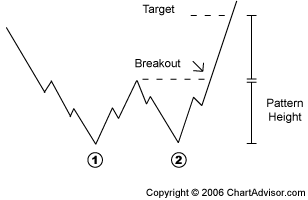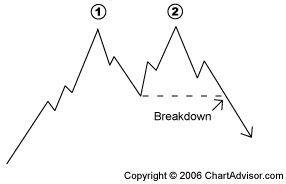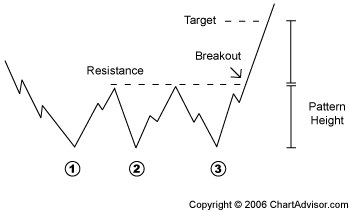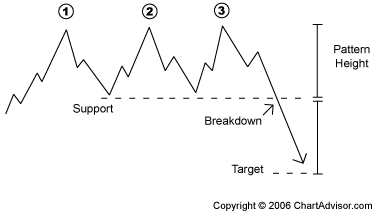The Symmetrical Triangle: A Reliable Workhorse
You’ll recognize the symmetrical triangle pattern when you see a stock’s price vacillating up and down and converging towards a single point. Its back and forth oscillations will become smaller and smaller until the stock reaches a critical price, breaks out of the pattern, and moves drastically up or down.
The symmetrical triangle pattern is formed when investors are unsure of a stock’s value. Once the pattern is broken, investors jump on the bandwagon, shooting the stock price north or south.
If you see a symmetrical triangle forming, watch it closely. The sooner you catch the breakout, the more money you stand to make.
Watch For:
• Sideways movement, a period of rest, before the breakout.• Price of the asset traveling between two converging trendlines.• Breakout ¾ of the way to the apex.
Set Your Target Price:
As with all patterns, knowing when to get out is as important as knowing when to get in. Your target price is the safest time to sell, even if it looks like the trend may be continuing.For symmetrical triangles, sell your stock at a target price of:
• Entry price plus the pattern’s height for an upward breakout.• Entry price minus the pattern’s height for a downward breakout.
2.Profitable Pattern Number Two
When you notice a stock has a series of increasing troughs and the price is unable to break through a price barrier, chances are you are witnessing the birth of an ascending triangle pattern.
Sponsor:Instant delivery of explicit forex trade alerts sounds like something you might be interested in - try them FREE for 30 days!
How to Profit from Ascending and Descending Triangles
Ascending and descending triangles are short-term investor favorites, because the trends allow short-term traders to earn from the same sharp price increase that long-term investors have been waiting for. Rather than holding on to a stock for months or years before you finally see a big payday, you can buy and hold for only a period of days and reap in the same monster returns as the long-time stock owners.
As with many of our favorite patterns, when you learn to identify ascending and descending triangles, you can profit from upwards or downwards breakouts. That way, you’ll earn a healthy profit regardless of where the market is going.
Watch For:
• An ascending or descending pattern forming over three to four weeks.
Set Your Target Price:
For ascending and descending triangles, sell your stock at a target price of:
Entry price plus the pattern’s height for an upward breakout.• Entry price minus the pattern’s height for a downward breakout.
3.Profitable Pattern Number Three
The head and shoulders pattern is a prevailing pattern among short sellers, investors who profit from downtrends. After three peaks, the stock plummets, offering a textbook, high-return opportunity to traders who catch the trend early.
How to Profit from the Head and Shoulders Pattern
• Short sell as soon as the price moves below the neckline after the descent from the right shoulder.
Set Your Target Price:
For the head and shoulders pattern, buy shares at a target price of:
• Entry price minus the pattern’s height (distance from the top of the head to the neckline).
4&5Profitable Patterns Number Four and Five
When you see a W or M pattern forming, you may have just discovered a money-making double bottom or double top pattern. These patterns are common reversal patterns used to suggest the current stock trend may be likely to shift.
But don’t panic if your double bottom or double top patterns do not develop as you had originally thought. You haven’t lost your chance for cash. If your W or M pattern reverses for a fourth time, you could now be working with the profitable triple bottom or triple top.
Double Bottom Pattern
 |
| Double Bottom Pattern A small peak is surrounded by two equal troughs. |
Purchase When:
• The price exceeds the middle-peak price.
Watch For:
• A price increase of 10% to 20% from the first trough to the middle peak.
• Two equal lows, not to differ by more than 3% or 4%.
Set Your Target Price:
For the double bottom pattern, sell your stock at a target price of:
• Entry price plus the pattern’s height (distance from the peak to the bottom of the lowest trough).
Double Top Pattern
 |
| Double Top Pattern A small trough is surrounded by two equal peaks. |
Short Sell When:
• The price drops below the middle-trough price.
Watch For:
• A price decrease of 10% to 20% from the first peak to the middle trough.
• Two equal highs, not to differ by more than 3% or 4%.
Set Your Target Price:
For the double top pattern, buy shares at a target price of:
• Entry price minus the pattern’s height (distance from the trough to the top of the highest peak).
Triple Bottom Pattern
 |
| Triple Bottom Pattern Three equal troughs amid a series of peaks. |
Purchase When:
• The price exceeds the resistance established by the prior peaks.
Watch For:
• A series of three identical troughs at the end of a prolonged downtrend.
Set Your Target Price:
For triple bottom patterns, sell your stock at a target price of:
• Entry price plus the pattern’s height (distance from the resistance to the bottom of the lowest trough).
Triple Top Pattern
 |
| Triple Top Pattern Three equal peaks amid a series of troughs. |
Purchase When:
• The price falls below the support that formed from the prior troughs.
Watch For:
• A series of three peaks at relatively the same level.
Set Your Target Price:
For triple top patterns, buy shares at a target price of:
• Entry price minus the pattern’s height (distance from the support to the top of the highest peak).
Now You Know…
The five most profitable stock patterns:
• symmetrical triangle
• ascending and descending triangles
• head and shoulders
• double top and double bottom
• triple top and triple bottom
How to Minimize Your Risk
No investment advisor likes to admit it, but no stock picking system is perfect. Sometimes, the stocks we think will explode, don’t. Sometimes, the stocks we feature lose money.
There may not be a foolproof system to predicting the stock market, but we do have a foolproof system for managing risk. ChartAdvisor follows one of the safest risk reduction systems available.
Using these three simple steps, you can reduce the risk in your stock picking plan:
Three Ways to Take Risk Out of the Stock Market
1. Screen Your Picks. This might seem obvious, but patterns that look like they are developing into predictable trends do not always follow through. After combing over thousands of stock charts a day, ChartAdvisor will often not fetures a single stock.
2. Get In. Get Out. ChartAdvisor preaches setting realistic target exit prices for all stocks. We lock in high returns while the stock is high, and we get out before the market has a chance to change its mind.
3. Set Tight Stop Losses This step is absolutely critical to minimizing your risk in the stock market. If a sure-fire winner turns out to be a fizzled-out dud, your system needs to have a built-in, abandon-ship trigger. That is, you need to know when to cut your losses and move on to brighter prospects.
===> Click
BACK TO CHAT BOX
.png)





1 comment:
moderator,
pls delete the nick "Dali" from your chatbox, its an imposter using my nick... i do not wish your readers and chatters to be misled by ppl playing around... if I do decide to chat, I will apply with my gmail account. ..tks.
dali
Post a Comment